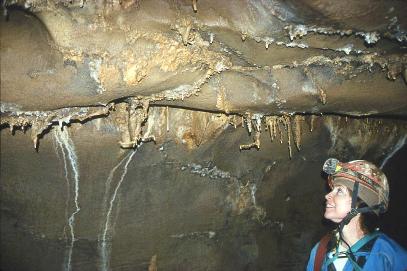Friars Hole Cave and Crookshank Pit
Sept 27-29, 2002
 | See the Photos! |
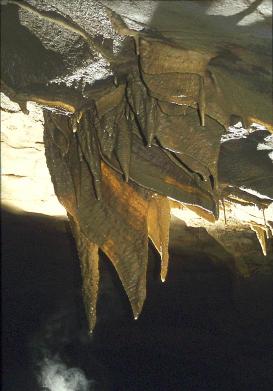
 It's been a long time since I had a chance to do any non-project caving. At nearly 45 miles in length, the Friars Hole System is currently the 19th longest in the world and the 6th longest in the US. Originally, there were six caves (Friars Hole, Snedegar's, Crookshank, Rubber Chicken, Toothpick and Canadian Hole) in the Friars Hole Valley which were connected in the 1970s and 80s by a series of heroic expeditions. Indeed a history of the cave system features many of the brightest luminaries of East Coast caving and some of the hairiest stories. Thus Amy and I jumped at the chance to join Pete Penczer and a company of others in an expedition to such a storied and fabulous cave.
It's been a long time since I had a chance to do any non-project caving. At nearly 45 miles in length, the Friars Hole System is currently the 19th longest in the world and the 6th longest in the US. Originally, there were six caves (Friars Hole, Snedegar's, Crookshank, Rubber Chicken, Toothpick and Canadian Hole) in the Friars Hole Valley which were connected in the 1970s and 80s by a series of heroic expeditions. Indeed a history of the cave system features many of the brightest luminaries of East Coast caving and some of the hairiest stories. Thus Amy and I jumped at the chance to join Pete Penczer and a company of others in an expedition to such a storied and fabulous cave. We left Baltimore on Friday afternoon and drove through intermittent rain the six hours to southern West Virginia and the Cave Preserve. There was quite a bit of confusion when we arrived in the area and several hours of exciting driving back and forth on dirt roads was required to finally find the campsite. My profound appologies to the local couple I bothered significantly after midnight to ask directions! When we finally pulled in, we found a lovely campsite next to a cabin at the edge of a field. Paul Thomas and Chris Newton had arrived several hours earlier. Pete Penczer and Paul Gillis arrived on our heels. Fellow Gangsta Mapper and caving buddy Pat Bingham arrived early the next morning making us a septet.
We left Baltimore on Friday afternoon and drove through intermittent rain the six hours to southern West Virginia and the Cave Preserve. There was quite a bit of confusion when we arrived in the area and several hours of exciting driving back and forth on dirt roads was required to finally find the campsite. My profound appologies to the local couple I bothered significantly after midnight to ask directions! When we finally pulled in, we found a lovely campsite next to a cabin at the edge of a field. Paul Thomas and Chris Newton had arrived several hours earlier. Pete Penczer and Paul Gillis arrived on our heels. Fellow Gangsta Mapper and caving buddy Pat Bingham arrived early the next morning making us a septet.
Saturday
The daylight revealed the campsite at the Preserve in its true glory. We were camped in soft grass at the edge of an occupied cow pasture between steep hills covered with just-turning trees. A brook, swollen from yesterday's rains, fell over large stones and vanished into one of the large entrances to Snedegar's cave across the road. No trace of a cloud could be seen nor could we hear any traffic or other woes of city life. Like they say, Almost Heaven. We had a leisurely breakfast, geared up and drove to the entrance of Friars Hole Cave propper.  Though the system has eight entrances, the Friars Hole portion has only one and it requires negotiating two 25 foot, waterfall-equipped pits. This would be the first in-cave vertical experience for Chris, Amy and Paul Thomas. Chris, Paul T. and I were sent in with a pair of ropes (75' and 100') to take care of the rigging while the others followed behind. The entrance itself was not immediately clear and Chris was dispatched to scout out the most likely small hole. He soon reported that it opened up and headed down which seemed like the right trend.
Though the system has eight entrances, the Friars Hole portion has only one and it requires negotiating two 25 foot, waterfall-equipped pits. This would be the first in-cave vertical experience for Chris, Amy and Paul Thomas. Chris, Paul T. and I were sent in with a pair of ropes (75' and 100') to take care of the rigging while the others followed behind. The entrance itself was not immediately clear and Chris was dispatched to scout out the most likely small hole. He soon reported that it opened up and headed down which seemed like the right trend. After a bit of clean, dark breakdown and a rather tretcherous 15' climbdown, we emerged into a compact, stream-carved corridor. Around the next bend, the passage opened up into the first of the pits and the stream dropped to a pool below in a noisy waterfall. The chamber itself was about 20 feet in diameter with many water-carved protrusions and embayments. Very pretty. I spied the pair of bolts a little ways around the wall of the pit which was to be our anchor point for the drop.
After a bit of clean, dark breakdown and a rather tretcherous 15' climbdown, we emerged into a compact, stream-carved corridor. Around the next bend, the passage opened up into the first of the pits and the stream dropped to a pool below in a noisy waterfall. The chamber itself was about 20 feet in diameter with many water-carved protrusions and embayments. Very pretty. I spied the pair of bolts a little ways around the wall of the pit which was to be our anchor point for the drop.  Other cavers may enjoy tight squeezes, muddy slithing or wading through neck-deep water, but rigging and vertical work is what I live for! This was perfect and I was in my element. Paul and I set up a bellay line around a neck of rock and I slithered out across a low, wide shelf near the ceiling to access the rig point. Several carabiners and a figure-8 on a bight comprised the basic rigging and I spent some time adjusting the strands in the cumbersome knot to equalize forces. Voila! First pit rigged. I rappelled down first landing in the shallow, spray-whipped pool below. Paul Gillis, photographer extraordinare, snapped a few photos on the way down. The other Paul followed me with Chris hot on his heals.
Other cavers may enjoy tight squeezes, muddy slithing or wading through neck-deep water, but rigging and vertical work is what I live for! This was perfect and I was in my element. Paul and I set up a bellay line around a neck of rock and I slithered out across a low, wide shelf near the ceiling to access the rig point. Several carabiners and a figure-8 on a bight comprised the basic rigging and I spent some time adjusting the strands in the cumbersome knot to equalize forces. Voila! First pit rigged. I rappelled down first landing in the shallow, spray-whipped pool below. Paul Gillis, photographer extraordinare, snapped a few photos on the way down. The other Paul followed me with Chris hot on his heals.
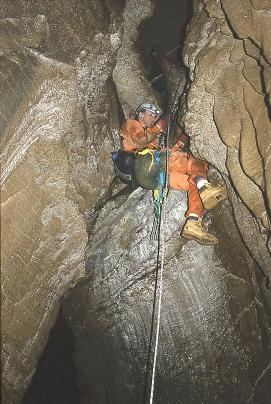 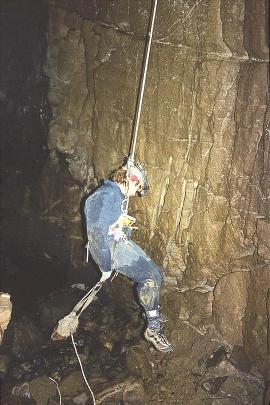 |
 After the first pit, we negotiated a bit of hands-and-knees work through an active stream. Paul found a sizeable crayfish under one rock which was a new sight for me. A bit of squeezing brought us to a tall, tight canyon. The stream fell away below us almost immediately but we were able to proceed on breakdown blocks wedged into the chasm or by stemming across the narrow slot for another thirty or forty feet. Just as the canyon widened out, I reached a nice shelf with a pair of bolts above a clean drop. Having used the 75' rope on the previous drop, we broke out the 100-footer and went to work. I lowered the rope until it just touched, added five feet for good measure and then used the same setup as before. The remaining 50' of line was turned into a traverse line for the dangerous bit of canyoneering above the waterfall.
After the first pit, we negotiated a bit of hands-and-knees work through an active stream. Paul found a sizeable crayfish under one rock which was a new sight for me. A bit of squeezing brought us to a tall, tight canyon. The stream fell away below us almost immediately but we were able to proceed on breakdown blocks wedged into the chasm or by stemming across the narrow slot for another thirty or forty feet. Just as the canyon widened out, I reached a nice shelf with a pair of bolts above a clean drop. Having used the 75' rope on the previous drop, we broke out the 100-footer and went to work. I lowered the rope until it just touched, added five feet for good measure and then used the same setup as before. The remaining 50' of line was turned into a traverse line for the dangerous bit of canyoneering above the waterfall. From here on, the going got easier and much less exciting. Everyone else appeared on the ledge and rappelled down with no trouble. I was pleased to see Amy come down like a pro. Paul collected more photos. We stashed our vertical gear and prepared for horizontal caving. After a nice bit of rocky tunnel, we emerged into the massive stream trunk of Friar's Hole. The floor was sandy with breakdown and a sizeable stream flowed south-west from the upper reaches of the cave.
From here on, the going got easier and much less exciting. Everyone else appeared on the ledge and rappelled down with no trouble. I was pleased to see Amy come down like a pro. Paul collected more photos. We stashed our vertical gear and prepared for horizontal caving. After a nice bit of rocky tunnel, we emerged into the massive stream trunk of Friar's Hole. The floor was sandy with breakdown and a sizeable stream flowed south-west from the upper reaches of the cave.
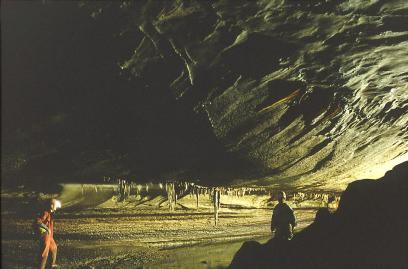
The main stream trunk.
 We flipped a mental coin and proceeded upstream through huge passage usually 50 to 100 feet wide with a 10 to 30 foot ceiling. The walking was very easy and we crossed from side to side as the stream meandered and babbled through. Shortly Amy and Pat found a nice set of large helectites and we spent a while photographing them. Eventually, we had lunch and more photo opportunities near a pretty bend in the passage and deep pool. More crayfish from two to four inches long could be seen as well as a few two-inch salamanders floating listlessly.
We flipped a mental coin and proceeded upstream through huge passage usually 50 to 100 feet wide with a 10 to 30 foot ceiling. The walking was very easy and we crossed from side to side as the stream meandered and babbled through. Shortly Amy and Pat found a nice set of large helectites and we spent a while photographing them. Eventually, we had lunch and more photo opportunities near a pretty bend in the passage and deep pool. More crayfish from two to four inches long could be seen as well as a few two-inch salamanders floating listlessly. After an hour or two of wandering, the giant passage began to branch off into smaller infeeders. Farther upstream lay the arduous Dung-Ho Way full of hip-deep water and other nasty surprises. We explored a series of Domes instead and studied a pair of bat skeletons. Paul took more photos using remote flashes and other fancy gear I have thusfar only dreamed about. After another short break, we turned the trip and headed back out.
After an hour or two of wandering, the giant passage began to branch off into smaller infeeders. Farther upstream lay the arduous Dung-Ho Way full of hip-deep water and other nasty surprises. We explored a series of Domes instead and studied a pair of bat skeletons. Paul took more photos using remote flashes and other fancy gear I have thusfar only dreamed about. After another short break, we turned the trip and headed back out.
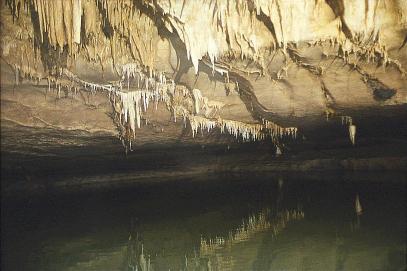
 The trip out was much like the trip in. At one point we stopped and played photo-sherpas/models for Paul as he worked on capturing a particularly decorated portion of the large stream passage. Mostly we just trod over breakdown and sandy floor and splashed through the stream. At length we made it back to the turn-off for the exit. There was some thought that perhaps the downstream passage would be more interesting, but the majority voted for a retreat.
The trip out was much like the trip in. At one point we stopped and played photo-sherpas/models for Paul as he worked on capturing a particularly decorated portion of the large stream passage. Mostly we just trod over breakdown and sandy floor and splashed through the stream. At length we made it back to the turn-off for the exit. There was some thought that perhaps the downstream passage would be more interesting, but the majority voted for a retreat. After some checking by Pete, Chris took the first trip up the first rope. I followed and noticed a disturbing rubbing spot. Pete sent up one of his funky tubular rope pads and the situation was remedied. Pat joined me on the ledge and followed Chris while Amy came smartly up the rope. We moved on ahead to clear the way for the final three. By the time Amy and I had negotiated the traverse line and reached the upper climb, Chris was long-gone and Pat was just clearing the rope. I climbed up next surprised at how little spray I encountered despite the thundering falls. Pete arrived at the bottom, checked out Amy's system and sent her up. Happily perched atop the upper rope, I was content to snap photos while Amy slithered to the stream passage leading to the exit.
After some checking by Pete, Chris took the first trip up the first rope. I followed and noticed a disturbing rubbing spot. Pete sent up one of his funky tubular rope pads and the situation was remedied. Pat joined me on the ledge and followed Chris while Amy came smartly up the rope. We moved on ahead to clear the way for the final three. By the time Amy and I had negotiated the traverse line and reached the upper climb, Chris was long-gone and Pat was just clearing the rope. I climbed up next surprised at how little spray I encountered despite the thundering falls. Pete arrived at the bottom, checked out Amy's system and sent her up. Happily perched atop the upper rope, I was content to snap photos while Amy slithered to the stream passage leading to the exit.
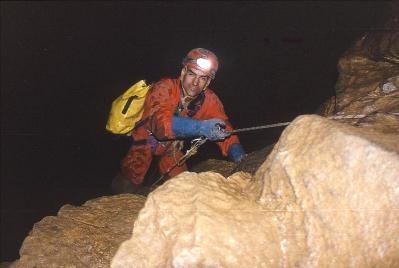 Pete dozes off on the final climb. |
 The two Pauls were dealing with derigging the lower rope and we all congregated atop the upper waterfall while they arrived. Finally, we were all up, ropes were coiled and we headed out. Emerging last from the hole, I was pleasently surprised to see that it was still marginally daylight outside. Everything smelled wonderfully alive and the temerature was just perfect.
The two Pauls were dealing with derigging the lower rope and we all congregated atop the upper waterfall while they arrived. Finally, we were all up, ropes were coiled and we headed out. Emerging last from the hole, I was pleasently surprised to see that it was still marginally daylight outside. Everything smelled wonderfully alive and the temerature was just perfect. We drove back to camp and were treated to a sumptuous feast of tortelloni by Paul Gillis and red wine courtesy of Pete. Many thanks to both of them. A fire was constructed and we sat, supped and sipped for many hours under the spectacular stars.
We drove back to camp and were treated to a sumptuous feast of tortelloni by Paul Gillis and red wine courtesy of Pete. Many thanks to both of them. A fire was constructed and we sat, supped and sipped for many hours under the spectacular stars.Sunday
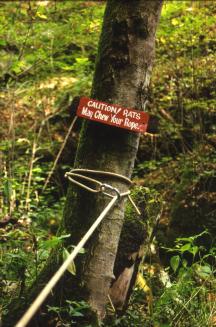 The unnerving sign nailed to the Crookshank Pit anchor tree. |
 Fortunately, we'd brought 200 feet of rope. Rigging oportunites were scarce with only one well-positioned tree about 50' back from the and we still had 100 feet of vertical drop to contend with. A red sign was nailed to the tree stating "Caution! Rats may chew your rope!" Nevertheless, the tree was rigged and Pete cautiously approached the edge. The rest of us stood guard for rats. A single bolt in a large block near the lip provided a nice directional and he attached our largest rope pad (a chunk of carpet with a cord on it) to protect the the rope from the fairly sharp edge. Three more rope pads were used in the next ten feet below as the rope curved over the steepening drop.
Fortunately, we'd brought 200 feet of rope. Rigging oportunites were scarce with only one well-positioned tree about 50' back from the and we still had 100 feet of vertical drop to contend with. A red sign was nailed to the tree stating "Caution! Rats may chew your rope!" Nevertheless, the tree was rigged and Pete cautiously approached the edge. The rest of us stood guard for rats. A single bolt in a large block near the lip provided a nice directional and he attached our largest rope pad (a chunk of carpet with a cord on it) to protect the the rope from the fairly sharp edge. Three more rope pads were used in the next ten feet below as the rope curved over the steepening drop.  After quite a while, there was a tremendous whoop from below as Pete touched down. When he reappeared, Chris got on rope and started his descent. This was his first experience with a large pit and he was cautious about it. Getting over the lip took about ten minutes and rope drag was conciderable. Eventually he yelled "Off Rope" and it was my turn.
After quite a while, there was a tremendous whoop from below as Pete touched down. When he reappeared, Chris got on rope and started his descent. This was his first experience with a large pit and he was cautious about it. Getting over the lip took about ten minutes and rope drag was conciderable. Eventually he yelled "Off Rope" and it was my turn. I have dropped the Cassell pit entrance many times which is of similar depth. Crookshank, however, is much larger in diameter and felt much bigger. Thus it was with some trepidation that I crawled backwards over the rope pad feeding rope through my rack. The rope pads presented a bit of a challenge, but after a few minutes I was feeding rope, dropping very slowly and admiring the soaring walls on all sides. Spectacular!
I have dropped the Cassell pit entrance many times which is of similar depth. Crookshank, however, is much larger in diameter and felt much bigger. Thus it was with some trepidation that I crawled backwards over the rope pad feeding rope through my rack. The rope pads presented a bit of a challenge, but after a few minutes I was feeding rope, dropping very slowly and admiring the soaring walls on all sides. Spectacular! Chris was waiting amongst the massive chunks of cross-bedded limestone that make up the floor of the pit. Time was of the essense and two more people were waiting patiently up top. I checked his vertical system, made a few suggestions and he was off on his way back out. Meanwhile, I wandered the base of the pit and got a chance to look around. Daylight from above filtered down as a dim greyness in which I could pretty much make out everything. The ceiling far, far above was a pale greyish green from sunlight reflecting in off leaves.
Chris was waiting amongst the massive chunks of cross-bedded limestone that make up the floor of the pit. Time was of the essense and two more people were waiting patiently up top. I checked his vertical system, made a few suggestions and he was off on his way back out. Meanwhile, I wandered the base of the pit and got a chance to look around. Daylight from above filtered down as a dim greyness in which I could pretty much make out everything. The ceiling far, far above was a pale greyish green from sunlight reflecting in off leaves. Soon enough it was my turn to ascend. After a few meters of sprinting to escape the edges of a small waterfall, I slowed down and began to enjoy the ascent. The rope pads and the edge appeared much more quickly than I expected and soon I was back on the surface. The time was now mid-afternoon and, with a long drive ahead of us, Amy and I bid adieu of the others.
Soon enough it was my turn to ascend. After a few meters of sprinting to escape the edges of a small waterfall, I slowed down and began to enjoy the ascent. The rope pads and the edge appeared much more quickly than I expected and soon I was back on the surface. The time was now mid-afternoon and, with a long drive ahead of us, Amy and I bid adieu of the others.A lovely, relaxing trip to a spectacular new cave. Many thanks to Pete for organizing the trip and getting us all pulling in the same direction. I hope to return someday for a more thorough exploration. With 45 miles of cave, it could very well take a while!
 The Wilderness Journal |  Neithernor |
